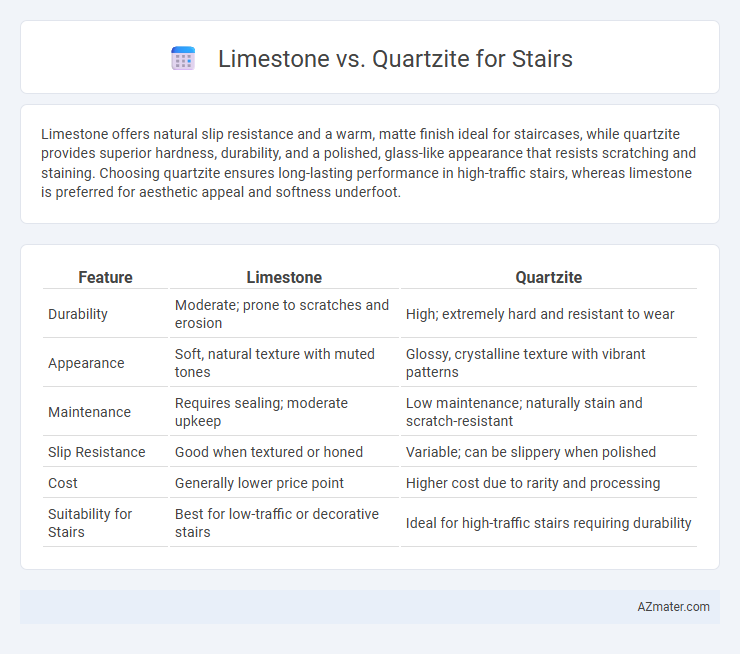Limestone offers natural slip resistance and a warm, matte finish ideal for staircases, while quartzite provides superior hardness, durability, and a polished, glass-like appearance that resists scratching and staining. Choosing quartzite ensures long-lasting performance in high-traffic stairs, whereas limestone is preferred for aesthetic appeal and softness underfoot.
Table of Comparison
| Feature | Limestone | Quartzite |
|---|---|---|
| Durability | Moderate; prone to scratches and erosion | High; extremely hard and resistant to wear |
| Appearance | Soft, natural texture with muted tones | Glossy, crystalline texture with vibrant patterns |
| Maintenance | Requires sealing; moderate upkeep | Low maintenance; naturally stain and scratch-resistant |
| Slip Resistance | Good when textured or honed | Variable; can be slippery when polished |
| Cost | Generally lower price point | Higher cost due to rarity and processing |
| Suitability for Stairs | Best for low-traffic or decorative stairs | Ideal for high-traffic stairs requiring durability |
Introduction to Limestone and Quartzite for Stairs
Limestone and quartzite are popular natural stone choices for stairs due to their durability and aesthetic appeal. Limestone is a sedimentary rock known for its soft, porous texture and warm, earthy tones, making it ideal for indoor staircases with a classic look. Quartzite, a metamorphic rock formed from sandstone, offers superior hardness and resistance to abrasion, providing a sleek, modern appearance for high-traffic stair areas.
Physical Properties Comparison
Limestone is a sedimentary rock characterized by its relatively low hardness (3-4 on the Mohs scale) and moderate porosity, making it more prone to scratching and staining compared to quartzite. Quartzite, a metamorphic rock formed from sandstone, exhibits superior hardness (7+ on the Mohs scale) and density, offering exceptional durability and resistance to abrasion, ideal for high-traffic stair applications. The higher compressive strength and lower water absorption rate of quartzite contribute to its enhanced longevity and maintenance ease over limestone in stair installations.
Aesthetic Appeal and Color Options
Limestone offers a soft, natural aesthetic with warm beige, cream, and gray tones that create an inviting atmosphere for staircases, while quartzite provides a more vibrant and varied palette, including whites, blues, and greens, adding a bold and luxurious look. The fine grain and subtle veining of limestone give stairs a classic and timeless elegance, whereas the dense, crystalline structure of quartzite delivers a striking, polished surface ideal for contemporary designs. Both materials are durable, but quartzite's hardness makes it more resistant to wear, maintaining its vivid colors and sharp edges longer on high-traffic stairs.
Durability and Longevity
Limestone offers moderate durability with a Mohs hardness of 3-4, making it more susceptible to scratches and wear over time when used for stairs. Quartzite, boasting a hardness of 7 on the Mohs scale, provides superior resistance to abrasion, chipping, and weathering, ensuring longer-lasting stair surfaces. For high-traffic areas, quartzite's exceptional strength and longevity make it a more durable choice compared to limestone.
Slip Resistance and Safety
Limestone has a naturally smooth surface that can become slippery when wet, posing safety concerns for stair usage, especially in high-traffic areas or outdoor stairs prone to moisture. Quartzite offers superior slip resistance due to its rougher, textured surface and higher hardness, making it a safer option for stair treads to reduce slip and fall risks. Choosing quartzite enhances overall stair safety by providing better traction and durability compared to the softer, more porous limestone.
Maintenance Requirements
Limestone stairs require regular sealing and gentle cleaning to prevent staining and erosion due to their porous nature, making maintenance more intensive compared to quartzite. Quartzite is highly durable and less porous, allowing it to resist scratches, stains, and moisture with minimal upkeep, ideal for high-traffic stair areas. Choosing quartzite reduces long-term maintenance costs while limestone demands consistent care to preserve its appearance and structural integrity.
Cost and Budget Considerations
Limestone generally costs less than quartzite, making it a more budget-friendly option for stair installations while still offering natural beauty and durability. Quartzite, known for its exceptional hardness and resistance to wear, commands a higher price but provides a longer-lasting surface that can justify the initial investment over time. When budgeting for stairs, factors like material cost per square foot, installation complexity, and maintenance expenses should be carefully evaluated to balance upfront costs with long-term value.
Installation Process and Complexity
Limestone stairs typically require careful sealing and moisture protection during installation due to its porous nature, which can extend the preparation and finishing time. Quartzite, being much harder and denser, demands specialized cutting tools and more labor-intensive handling, increasing installation complexity but yielding greater durability. Choosing between the two depends on balancing installation challenges with long-term wear resistance and maintenance needs.
Environmental Impact and Sustainability
Limestone stairs have a lower environmental impact due to their natural abundance and less energy-intensive quarrying process compared to quartzite, which requires more energy for extraction and processing. Limestone is more sustainable as it is more easily recyclable and biodegradable, whereas quartzite is highly durable but less eco-friendly to produce. Choosing limestone over quartzite can significantly reduce the carbon footprint associated with staircase materials in sustainable construction projects.
Best Applications: Which Stone Suits Your Stairs?
Limestone offers a softer, more porous surface ideal for indoor stairs with low foot traffic, providing a classic, warm aesthetic well-suited for residential settings and decorative applications. Quartzite, known for its exceptional hardness and resistance to abrasion, is perfect for high-traffic stairs in commercial or outdoor environments, ensuring durability and long-lasting performance. When choosing between limestone and quartzite for stairs, prioritize quartzite for strength and weather resistance, while limestone fits best in controlled environments where subtle elegance is desired.

Infographic: Limestone vs Quartzite for Stair
 azmater.com
azmater.com